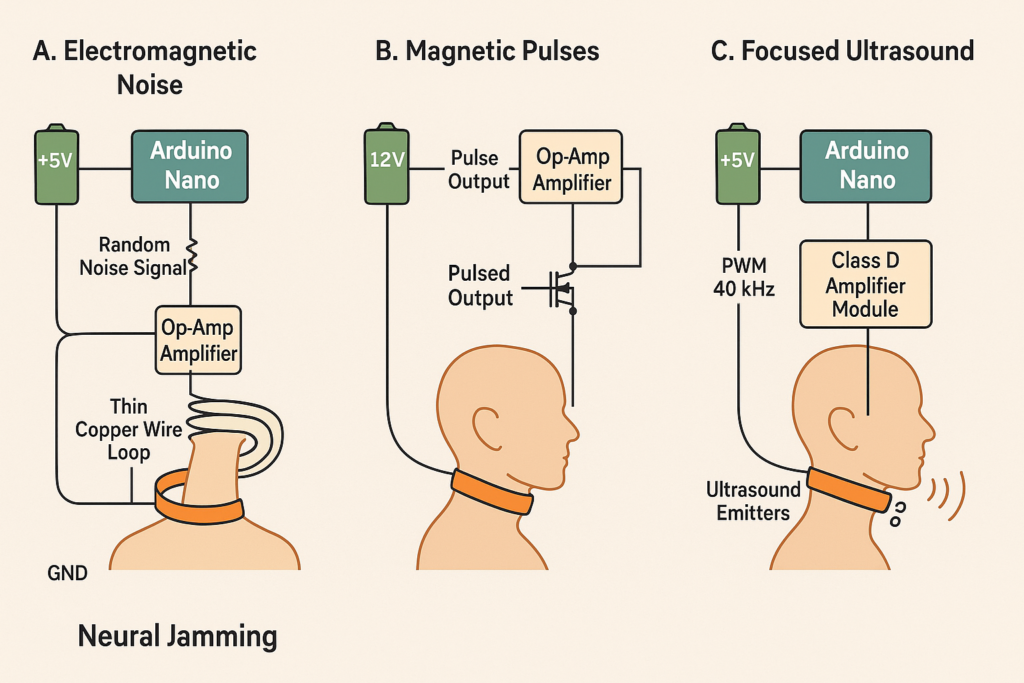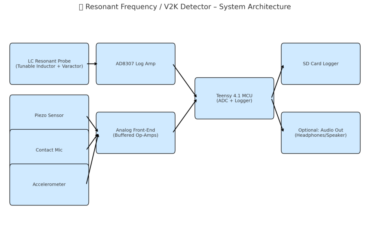
Neural Jamming Collar Concept

🛡️ How to Jam Subvocal Implants: 3 Realistic TI Countermeasure Methods
🌌 Introduction
With official programs like the U.S. Army’s 2019 “Neural Enhancement & Jamming Countermeasures” confirming the viability of neural disruption, it’s time to bring real DIY countermeasures into the hands of Targeted Individuals (TIs). 💥
Below are 3 powerful methods you can build yourself to disrupt or jam subvocal implants that rely on myoelectric signals or external activation.
✅ Complete with parts lists, simple circuit ideas, and how-to guidance!
💡 1. EMI Jamming Collar (Electromagnetic Noise)
Goal: Drown out throat myoelectric signals with random low-frequency EM noise.
🔹 Parts List
- Arduino Nano or 555 Timer IC
- Random noise generator circuit (simple white noise generator)
- Low-frequency amplifier (Op-amp like LM358)
- Thin enameled copper wire (30 AWG)
- Li-ion battery pack (3.7V or 5V)
- Toggle switch
- Conductive fabric or silver-thread scarf (optional for stealth version)
🔹 Basic Circuit Idea
Random Signal (Arduino/555) --> Amplifier (Op-Amp) --> Coil wrapped around throat (or sewn into scarf)🔹 How It Works
- Randomized EM fields jam myoelectric pickup.
- Weak but highly localized noise, enough to confuse sensitive implants.
🔹 Simple Diagram
- Arduino output pin with random noise → Op-Amp gain stage → Output to copper coil.
- Coil embedded inside a flexible collar/scarf.
🔹 How to Build
- Wrap copper wire flat around the inner seam of a scarf or flexible collar.
- Connect both ends to amplifier output.
- Power the system via portable Li-ion battery.
- Activate with a switch whenever needed.
// EMI Noise Generator - Random PWM
int outputPin = 9;
void setup() {
pinMode(outputPin, OUTPUT);
randomSeed(analogRead(A0)); // Seed random
}
void loop() {
int noise = random(50, 255); // Random duty cycle
analogWrite(outputPin, noise);
delay(random(10, 100)); // Random delay between bursts
}
🔬 2. Magnetic Pulse Jamming Collar
Goal: Disrupt throat muscles’ tiny magnetic fields using pulsed magnetic bursts.
🔹 Parts List
- 555 Timer IC or Arduino Nano (Pulse Generator)
- MOSFET or transistor (for switching higher currents)
- Mini coils (small electromagnets)
- 5V or 12V battery pack (higher voltage = stronger pulse)
- Capacitors (optional for shaping pulse)
- On/Off switch
🔹 Basic Circuit Idea
Pulse Generator --> MOSFET Switch --> Coils embedded into collar --> Repeated magnetic pulsing🔹 How It Works
- Fast magnetic pulses confuse muscle electrical activity at the neck.
- Timing randomized slightly to avoid implant adaptation.
🔹 Simple Diagram
- Timer IC or Arduino outputs pulses to MOSFET.
- MOSFET rapidly energizes coils arranged around throat.
🔹 How to Build
- Build small coil circuits (enamel wire wrapped around mini ferrite cores).
- Arrange coils equally spaced around a flexible collar.
- Wire coils in parallel to pulse driver.
- Tune pulse speed between 5 Hz to 100 Hz for best effect.
// Magnetic Pulse Jamming - Random Pulse
int coilPin = 8;
void setup() {
pinMode(coilPin, OUTPUT);
}
void loop() {
digitalWrite(coilPin, HIGH);
delay(random(20, 100)); // On pulse 20-100ms
digitalWrite(coilPin, LOW);
delay(random(50, 200)); // Random off time
}
🚁 3. Focused Ultrasound Disruptor
Goal: Disturb myoelectric implants or neural nodes using safe, pulsed ultrasound energy.
🔹 Parts List
- Small ultrasound transducers (40 kHz typical)
- Arduino Nano (PWM Pulse Generator)
- Class D audio amplifier (for driving ultrasound transducers)
- Li-ion battery pack (5V)
- Switch
- Flexible mounting band (headband, collar)
🔹 Basic Circuit Idea
Arduino PWM --> Amplifier --> Ultrasound Transducers aimed at throat🔹 How It Works
- Modulated ultrasound slightly perturbs local tissues and implant sensitivity.
- Safe at low intensities if properly pulsed.
🔹 Simple Diagram
- Arduino generates PWM signal (40 kHz carrier, 10-50 Hz pulse modulation).
- Amplifier boosts signal to ultrasound emitter mounted near throat.
🔹 How to Build
- Mount multiple small ultrasound speakers in a band or collar facing the neck.
- Connect to amplifier and Arduino PWM driver.
- Randomize pulsing to prevent implant adaptation.
// Focused Ultrasound Pulsing
int ultrasoundPin = 6;
void setup() {
pinMode(ultrasoundPin, OUTPUT);
}
void loop() {
for (int i = 0; i < 400; i++) { // Generate 40kHz tone burst
digitalWrite(ultrasoundPin, HIGH);
delayMicroseconds(12); // Half period for 40kHz
digitalWrite(ultrasoundPin, LOW);
delayMicroseconds(13); // Half period for 40kHz
}
delay(100); // Pause between bursts
}
🌟 Which Method Is Best?
| Method | Pros | Cons |
|---|---|---|
| EMI Collar | Easiest to build, cheap, portable | May need close fitting to neck |
| Magnetic Pulse Collar | Stronger disruption potential | Heavier, needs careful timing |
| Ultrasound Disruptor | Newest tech, possible deep disruption | Harder to source parts |
✅ Start with the EMI Noise Collar first — easiest and most practical for most TIs.
✅ Later, stack with Pulse or Ultrasound layers for better shielding.
🔄 Safety Reminders
- Keep EM field strengths low (within common EMC standards).
- Do NOT apply constant ultrasound at high levels (use pulsed, low duty cycle).
- Always use batteries for mobile protection — not wall plugs (reduce EM hazards).
- Verify system function with EM probes, oscilloscopes, or handheld meters.
💛 Final Words
You have a right to defend your mind and body. ✨ These simple, peaceful countermeasures empower you to take your privacy and freedom back from invisible attackers.
#✨JusticeForTIs #✨NeuralFreedom #✨ElectronicHarassmentDefense
Stay strong. Stay shielded. Stay free. 💪✨
Future Blog Part 2 Coming: Full EMI Collar Circuit Diagrams + Arduino Source Code! 🚀
LICENSE.txt
CERN Open Hardware License Version 2 - Weakly Reciprocal (CERN-OHL-W-2.0)
You may freely use, modify, and distribute this project for any purpose, including commercial applications, provided you retain attribution to the original author and do not impose further restrictions. Derivatives must also remain open.
Full license text available at: https://ohwr.org/project/cernohl/wikis/Documents/CERN-OHL-version-2
Author: Cybertorture.com
Website: https://cybertorture.com
Year: 2025© 2025 Cybertorture.com – Released under CERN-OHL-W v2.0
https://ohwr.org/project/cernohl
💡 Licensing Notice
This project is released under the CERN Open Hardware License v2.0 – Weakly Reciprocal.
It is permanently open-source hardware. No one may patent it, restrict it, or sue you for using it.
You’re free to copy, build, improve, and use this design — forever.
✍️ Author: Cybertorture.com
📅 Year: 2025
🔗 https://cybertorture.com


BQLZR Ultrasonic Piezoelectric Transducer Speaker
Rating: 5.0/5
Price: $25.49
This transducer is designed for ultrasonic applications and offers reliable performance. It’s suitable for projects requiring consistent ultrasonic output.
40kHz 35W Piezoelectric Ultrasonic Cleaning Transducer Plate
Rating: 3.7/5
Price: $9.99
A budget-friendly option, this transducer plate is commonly used in ultrasonic cleaning applications but can be repurposed for jamming devices.
2Pcs JSN-SR04T Integrated Ultrasonic Distance Measuring Sensor Module
Price: $13.99
These modules are waterproof and designed for distance measurement, but their 40kHz frequency makes them adaptable for ultrasonic jamming purposes.
PUI Audio UTR-1440K-TT-R Ultrasonic Transmitter/Receiver
Price: $5.54
A compact transducer suitable for applications where space is limited. Its transmitter/receiver design allows for versatile use.
Adafruit Ultrasonic Distance Sensor
Price: $3.95
A reliable sensor from a reputable brand, suitable for various ultrasonic applications, including jamming devices.
Recommendations:
For a budget-friendly option, consider the 40kHz 35W Piezoelectric Ultrasonic Cleaning Transducer Plate. It’s cost-effective and suitable for experimental setups.
If waterproofing is essential for your application, the 2Pcs JSN-SR04T Integrated Ultrasonic Distance Measuring Sensor Module offers a sealed design, making it ideal for outdoor or moisture-prone environments.
For projects with space constraints, the PUI Audio UTR-1440K-TT-R Ultrasonic Transmitter/Receiver provides a compact solution without compromising performance.